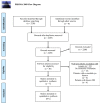Cost-effectiveness of diabetic retinopathy screening programs using telemedicine: a systematic review
- PMID: 32280309
- PMCID: PMC7137317
- DOI: 10.1186/s12962-020-00211-1
Cost-effectiveness of diabetic retinopathy screening programs using telemedicine: a systematic review
Abstract
Background: Diabetic retinopathy (DR) is a significant global public health and economic burden. DR accounts for approximately 15-17% of all cases of total blindness in the USA and Europe. Telemedicine is a new intervention for DR screening, however, there is not enough evidence to support its cost-effectiveness. The aim of this study is to review the most recent published literature on economic evaluations of telemedicine in DR screening and summarize the evidence on the cost-effectiveness of this technology.
Methods: A systematic search of PubMed, Embase and Google Scholar for relevant articles published between January 2010 and January 2020. Studies were included if they met the following criteria: (1) recruited subjects with either type 1, type 2 diabetes (2) evaluated telemedicine technology (3) patients underwent primary screening for DR (4) compared a telemedicine-based intervention with standard care (5) performed an economic evaluation or provided sufficient data for evaluating the cost-effectiveness of the technology used.
Results: Of 2238 articles screened, seven studies were included. Four of the studies were conducted in developed countries: The United States, Singapore and two studies in Canada. Three studies were conducted in developing countries: India, Brazil and South Africa. The patient populations in all studies were diabetic patients over the age of 18, previously not screened for DR. All seven studies used a telemedicine program which included capturing a retinal image and subsequently transmitting it to an ocular imaging center to assess the severity of DR. All studies compared telemedicine to a standard screening method for DR, including the option of no screening as standard of care. Although telemedicine requires initial and maintenance costs, it has the potential to provide significant cost savings by increasing patients' working ability, increasing independent living ability, increasing quality of life and reducing travel costs.
Conclusions: Diabetic retinopathy telemedicine technology has the potential to provide significant cost savings, especially in low-income populations and rural patients with high transportation costs.
Keywords: Cost-effectiveness; Diabetic retinopathy; Economic evaluation; Telemedicine screening; Teleophthalmology.
© The Author(s) 2020.
Conflict of interest statement
Competing interestsNone of the authors have any competing interests.
Figures
References
-
- WHO progress report on the implementation of the European Charter on Counteracting Obesity. 2018. http://www.euro.who.int/en/about-us/regional-director/speeches-and-prese.... Accessed 23 July 2018.
-
- For Disease Control C. National Diabetes Statistics Report, 2017 estimates of diabetes and its burden in the United States background. 2017. https://www.cdc.gov/diabetes/pdfs/data/statistics/national-diabetes-stat.... Accessed 28 Aug 2018.
Publication types
LinkOut - more resources
Full Text Sources
Miscellaneous


